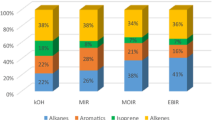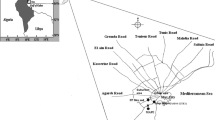Abstract
The potential role of isoprene oxidative processes, as well as the possible impact of air pollution on isoprene emissions, are more important in tropical cities, surrounded by rainforests. In this study, the contribution of isoprene to ozone formation was determined considering different scenarios, mainly volatile organic compounds/NO x (VOC/NO x ) ratios, and typical atmospheric conditions for the city of Rio de Janeiro, where more than 36% of the urbanized area is covered by vegetation. Ozone isopleths and incremental reactivity coefficients (IR) were evaluated to understand the direct contribution of isoprene to ground-level ozone formation and the negative impact of anthropogenic NO x emissions on the natural atmospheric balance. Although isoprene accounted for only 2.7% of the total VOC mass, excluding the isoprene concentration from the model reduced the maximum ozone value by 14.1%. The calculated IR coefficient (grams of O3 formed per gram of added isoprene) was 2.2 for a VOC/NO x ratio of 8.86.



Similar content being viewed by others
References
Artaxo P, Gatti LV, Leal AMC, Longo KM, Freitas SR, Lara LL, Pauliquevis TM, Procópio AS, Rizzo L (2005) Atmospheric chemistry in Amazonia: the forest and the biomass burning emissions controlling the composition of the Amazonian atmosphere. Acta Amazonica 35:185–196
Atkinson R (2000) Atmospheric chemistry of VOCs and NO x . Atmos Environ 34:2063–2101
Atkinson R, Arey J (2003) Atmospheric degradation of volatile organic compounds. Chem Rev 103:4605–4638
Carter WPL (2010) Development of the SAPRC-07 chemical mechanism. Atmos Environ 44:5324–5335
Carter WPL (2017). http://www.engr.ucr.edu/~carter/SAPRC/. Accessed 15 Sept 2017
Custodio D, Guimarães CS, Varandas L, Arbilla G (2010) Pattern of volatile aldehydes and aromatic hydrocarbons in the largest urban rainforest in the Americas. Chemosphere 79:1064–1069
Da Silva DBN, Martins EM, Correa SM (2016) Role of carbonyls and aromatics in the formation of tropospheric ozone in Rio de Janeiro, Brazil. Environ Monit Assess 188:289–301
DETRAN (2017). http://www.detran.rj.gov.br/_estatisticas.veiculos/07.asp. Accessed 15 Sept 2017
Finlayson-Pitts BJ, Pitts JJN (2000) Chemistry of the upper and lower atmosphere. Theory, experiments and applications. Academic Press, London
Geng F, Tie X, Guenther A, Li G, Cao J, Harley P (2011) Effect of isoprene emissions from major forests on ozone formation in the city of Shanghai, China. Atmos Chem Phys 11:10449–10459
Gery MW, Crouse RR (1990) User’s guide for executing OZIPR. US-EPA, Research Triangle Park
IBGE (2017). http://cidades.ibge.gov.br/xtras/perfil.php?codmun=330455. Accessed 15 Sept 2017
INEA (2016). Inventário Emissões veiculares. RMRJ. http://200.20.53.3:8081/cs/groups/public/@inter_vpres_geiat/documents/document/zwew/mti3/~edisp/inea0127611.pdf. Accessed 15 Sept 2017
Kesselmeier J, Staudt M (1999) Biogenic volatile organic compounds (VOC): an overview on emission, physiology and ecology. J Atmos Chem 33:23–88
Kesselmeier J, Kuhn U, Wolf A, Andreae MO, Ciccioli P, Brancaleoni E, Frattoni M, Guenther A, Greenberg J, Vasconcelos P, de C, Oliva, Artaxo T P (2000) Atmospheric volatile organic compounds (VOC) at a remote tropical forest site in central Amazonia. Atmos Environ 34:4063–4072
Lerdau M (2007) Ecology: a positive feedback with negative consequences. Science 316:212–213
Martins EM, Arbilla G (2003) Computer modeling study of ethanol and aldehyde reactivities in Rio de Janeiro urban air. Atmos Environ 37:1715–1722
Martins EM, Nunes ACL, Correa SM (2015) Understanding ozone concentrations during weekdays and weekends in the urban area of the city of Rio de Janeiro. J Braz Chem Soc 26:1967–1975
Ng NL, Brown SS et al. (2017) Nitrate radicals and biogenic volatile organic compounds: oxidation, mechanism, and organic aerosol. Atmos Chem Phys 17: 2103–2017
Rio (2017) Governo do Rio de Janeiro. Câmara Metropolitana. http://www.rj.gov.br/web/guest/exibeconteudo;jsessionid=C651B40DE0F6A464C15953E127A8AC27.lportal2?p_p_id=exibeconteudo_INSTANCE_2wXQ&p_p_lifecycle=0&refererPlid=11702&_exibeconteudo_INSTANCE_2wXQ_struts_action=%2Fext%2Fexibeconteudo%2Frss&_exibeconteudo_INSTANCE_2wXQ_groupId=103138&_exibeconteudo_INSTANCE_2wXQ_articleId=3730492. Accessed 15 Sept 2017
Shallcross DE, Monks PS (2000) New Directions: A role for isoprene in biosphere-climate-chemistry feedbacks. Atmos Environ 35:1659–1660
Sharkey TD, Wiberley AE, Donohue AR (2008) Isoprene emission from plants: why and how. Ann Bot 101:5–18
Silva CM, da Silva LL, Souza ECCA., Oliveira RL, Corrêa SM, Arbilla G (2016a) Volatile organic compounds in the atmosphere of the botanical garden of the city of Rio de Janeiro. Bull Environ Contam Toxicol 97:653–658
Silva CM, da Silva LL, Corrêa SM, Arbilla G (2016b) Kinetic and mechanistic reactivity. Isoprene impact on ozone levels in an urban area near Tijuca Forest, Rio de Janeiro. Bull Environ Contam Toxicol 97:781–785
Silva CM, Souza ECCA., da Silva LL, Oliveira RL, Arbilla G, Corrêa SM (2016c) Avaliação da eficiência do Método TO-15 para a determinação de compostos organicos voláteis em condições típicas de ambiente urbano. Quim Nova 39:1245–1253
SMAC (2017). http://jeap.rio.rj.gov.br/je-metinfosmac/boletim. Accessed 15 Sept 2017
Souza ECCA., Oliveira RL, Arbilla G (2016) Isoprene, benzene and toluene levels at the major landmarks of Rio de Janeiro during the 2014 FIFA World Cup. Atmósfera (México) 29:197–207
Steffen W, Richardson K, Rockstrom J, Cornell SE, Fetzer I, Bennett EM, Biggs R, Carpenter SR, Vries W, Wit CA, Folke C, Gerten D, Heinke J, Mace GM, Persson LM, Ramanathan V, Reyers B, Sorlin S (2015) Planetary boundaries: guiding human development on a changing planet. Science 347:1259855–12591-41
Tonnesen GS (2000) User’s guide for executing OZIPR version 2.0. USEPA, Research Triangle Park, NC
USEPA, USA Environmental Protection Agency (2017). https://www3.epa.gov/ttnamti1/airtox.html. Accessed 15 Sept 2017
Xie X, Shao M, Liu Y, Lu S, Chang CC, Chen ZM (2008) Estimate of initial isoprene contribution to ozone formation potential in Beijing, China. Atmos Environ 42:6000–6010
Yu Y, Wen S, Lu H, Feng Y, Wang X, Sheng G, Fu J (2008) Characteristics of atmospheric carbonyls and VOCs in Forest park in South China. Environ Monit Assess 137:275–285
Acknowledgements
The study was funded in part by FAPERJ, CNPq and CAPES. The authors also acknowledge data provided by SMAC.
Author information
Authors and Affiliations
Corresponding author
Rights and permissions
About this article
Cite this article
da Silva, C.M., Corrêa, S.M. & Arbilla, G. Isoprene Emissions and Ozone Formation in Urban Conditions: A Case Study in the City of Rio de Janeiro. Bull Environ Contam Toxicol 100, 184–188 (2018). https://doi.org/10.1007/s00128-017-2248-6
Received:
Accepted:
Published:
Issue Date:
DOI: https://doi.org/10.1007/s00128-017-2248-6




